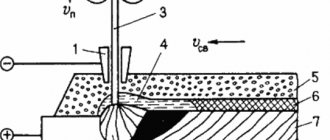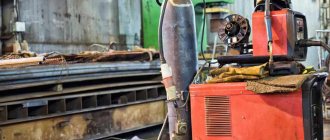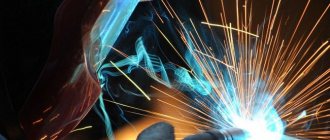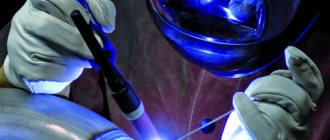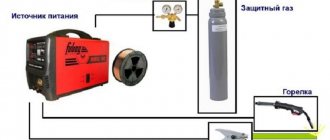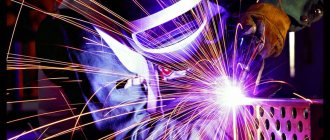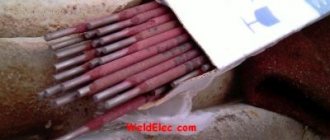The automatic machine ADG-502 (Fig. 9) is designed for direct current welding in a carbon dioxide environment of butt joints with and without cutting edges, fillet welds and overlap joints.
Rice. 9. Automatic ADH – 502
The machine is equipped with two parts: welding tractor 1 and arc power source 2 - rectifier VDU - 504. The operation of the machine is based on the principle of dependence of the electrode wire feed speed on the arc voltage. All control of the machine is carried out from a remote control located on the welding tractor. The control panel contains devices for monitoring the mode, regulators for arc voltage and welding speeds and electrode wire feed, as well as control buttons. The additional control panel mounted on the welding rectifier contains controls for the supply of shielding gas.
The welding tractor is similar to automatic machines of the ADF type, the difference is in the design of the current conductor, the presence of cooling water and shielding gas, the absence of a hopper for flux and a light indicator. The welding head is shown in Fig. 10.
Rice. 10. Welding head of the automatic machine ADG-502
One-sided welding by automatic machines on a copper moving slide.
This method was developed at the IES named after. Paton and was introduced into production in the form of the TS-32 assault rifle (Fig. 6.7.) and TS-44. This is a method of welding sheets along an increased gap using a movable cooled copper slider mounted on a trolley, which, using a special knife, was connected to a welding tractor through the gap between the sheets being welded. One of the requirements for this welding method is to maintain a constant initial gap between the sheets. This was achieved by the presence of assembly brackets installed across the future weld every 800 - 1200 mm and which must be removed during the welding process. Such machines made it possible to weld sheets of panels up to 12 mm thick. Later, at the Central Research Institute of TS, an analogue of these assault rifles was developed - a Brig type assault rifle. A significant disadvantage of this high-performance welding method was the presence of excess residual local welding deformations such as “waviness” (loss of stability) at thicknesses of 4-6 mm and “houses” at thicknesses of 8-12 mm at the ends of butt joints over a length of 800 - 1200 mm. Despite this drawback, the cost of assembling panel sheets decreased by 2 times, and the cost of welding by 1.5 times.
Semi-automatic devices. Installations for semi-automatic welding of the type PSh-5 (PSh-5U), PSh-54 under a layer of flux are currently not used in shipbuilding due to their disadvantages - significant weight of the holder (due to the hopper with flux), a small supply of flux, the impossibility of smooth regulation of wire feed speed.
The domestic industry has a large number of different automatic and semi-automatic machines for welding in shielding gases. In shipbuilding, automatic consumable electrode welding machines are used: ADPG-500, ADSP-1, TS-35 and non-consumable (tungsten) electrode – ADSV-2.
The ADPG-500 automatic machine is designed for welding with a consumable steel electrode in a shielding gas environment (CO2, Ar, He) butt and fillet welds in the lower position. The installation kit includes a welding arc power source (PSG-500 type converter), a control cabinet, a welding tractor and gas equipment. The welding tractor has parts that are unified with the ADF-500 automatic machine. The compact tractor is designed for welding with thin electrode wire with a diameter of 0.8 - 2 mm at current strengths of 150 - 500 A. The welding speed can be varied within the range of 15 – 70 m/h, and the wire feed speed is 90 – 960 m/h. The tractor can move around the product. Gas equipment consists (Fig. 6.8.) of a cylinder with protective gas, a reducer, a rotameter (gas flow meter) and connecting hoses. When welding in a CO2 environment, the gas system includes a dryer and a gas heater. The water-cooled heating pad provides protective gas supply within the range of 600 – 1500 l/h.
At shipbuilding plants, consumable electrode welding in shielding gases is most widely used as a semi-automatic method using semi-automatic machines PDPG-300, PDPG-500, A-537R, “Granit” and “Neva”, etc.
Semi-automatic machines PDPG-300 and PDPG-500 - the installation includes a welding power source (type PSG-350 or PSG-500), a control cabinet, a feeding mechanism with flexible hoses and welding guns and gas equipment (Fig. 6.8).
The feeding mechanism provides wire feeding with a diameter of 0.8-2.0 mm at a speed of up to 960 m/h. Semi-automatic machines are designed for welding with a consumable electrode in a shielded gas environment butt and fillet welds in any spatial position. Semiautomatic A-547R (A-547, A-547U) is designed for welding in a carbon dioxide environment; created at the IES named after. Paton. The peculiarity of the semi-automatic device is a lightweight pistol with a short hose from 0.8 to 1 m long (Fig. 6.9). The semi-automatic machine is designed for electrode wire with a diameter of 0.18 - 1.0 mm and is intended for welding thin-sheet steel up to 3 mm thick and fillet welds with a 4 mm leg in carbon dioxide.
For welding titanium alloys, automatic machines such as ADS-1000-2M, ADS-1000-2V, ASU-4MV and semi-automatic machines PGT-2, “Ri, etc.” are used.
Equipment for manual and mechanized welding with non-consumable electrodes in an inert gas environment. With this welding method, tungsten rods containing 1.5-2% lanthanum or yttrium oxide are used as a non-consumable electrode, which improve the emission of electrons from the electrode, which increases the stability of the arc. This method is most widely used for welding non-ferrous metals and alloys and stainless steels. In many cases, the welding arc is powered by an alternating current source, which is explained by the following.
Read also: Revolving press for brick production
When welding aluminum and its alloys based on it, as well as magnesium alloys, in order to destroy the refractory oxide film formed on the surface of the weld pool, reverse polarity (minus on the product) is necessary, since only with this inclusion the emission of electrons from the product (cathode) will destroy the surface film of oxides; Welding can be performed efficiently provided the weld pool is cleaned as specified. At the same time, with reverse polarity, the tungsten electrode heats up excessively. To avoid its melting, the welding current has to be reduced, and this reduces welding productivity.
When switching to alternating current, the weld pool is sufficiently cleaned during the half-cycle, when the product is the cathode; At the same time, alternating polarity allows you to increase the welding current and welding productivity. However, in this case, the appearance of a direct current component Iо (Fig. 6.10.) due to the fact that the electrodes are different metals (one electrode is tungsten, the other is aluminum).
More intense emission of electrons from the tungsten electrode causes the appearance of an asymmetrical alternating current sinusoid, from which a direct component can be separated. The direct current component has straight polarity, which worsens the quality of the welded joint (it makes it more difficult to destroy films, reduces the penetration depth, and worsens arc stability). Studies have shown [4,5] that the inclusion of ballast rheostats or a capacitance in a series welding circuit reduces or completely eliminates the direct current component. Therefore, when welding (mechanized or manual) aluminum alloys with a tungsten electrode, the welding circuit is usually powered with alternating current (Fig. 6.8b).
The installation includes: current source – welding transformer 1; choke for regulating the strength of welding current 2; oscillator for arc stabilization 3; ballast rheostat 4 to reduce the DC component; gas-electric burner 5 with a tungsten electrode, a gas system including a cylinder with argon 6, reducer 7, rotameter 8 and hoses for supplying argon. In the manual version, the gas-electric burner is moved manually. By attaching the control cabinet to the tractor and including the control cabinet in the installation, welding can be carried out automatically. Installations such as UDAR-300 and UDAR-500, as well as UDG-301 and UDG-501 are used in shipbuilding. To eliminate the DC component, capacitor banks are included in the welding circuit of these installations and there is an electronic voltage stabilizer. The diameter of the tungsten electrode is 2-6 mm. The ADSV-2 automatic machine is currently widely used in shipbuilding, which is designed for automatic welding of stainless steels and non-ferrous metals and alloys with a non-consumable tungsten electrode in an argon environment. Welding current is up to 400 A, welding speed is 10-80 m/h, filler wire diameter is 1-2.5 mm, its feed speed is up to 800 m/h.
Hybrid laser-arc welding. Basic principles. The use of an arc discharge as one of the most common and cheapest types of heat sources for welding encounters significant difficulties associated with insufficient energy concentration in the electric arc plasma and instability of the arc at high welding speeds [1, 3]. Therefore, at the moment, hybrid (mixed) welding methods, which include laser-arc welding, are increasingly being developed. This technology was obtained by combining laser welding and gas shielded welding technologies. Figure 6.11 shows the main methods for implementing hybrid arc welding.
The hybrid welding process can be implemented according to two schemes - in the first scheme, the laser beam and arc act from different sides, in the second scheme, the action of the arc and beam is carried out on one side in relation to the direction of welding and the normal to the metal surface. At the moment, due to the complexity of manufacturing equipment corresponding to the first scheme, the second scheme is used for welding. The laser-arc welding process can be carried out with both non-consumable and consumable electrodes. When using a non-consumable electrode, the arc is ignited ahead of the welding process. The arc heats the metal and melts its top layer, and the laser carries out deep penetration. When using a consumable electrode, an electric arc is ignited behind focused radiation, which melts only the parts of the metal in contact. The basis of the hybrid welding system is a special welding torch, which includes both laser optics and a gas-shielded welding torch (Fig. 6.12).
A schematic representation of the hybrid laser-arc welding method is shown in Fig. 6.13.
In hybrid welding, in addition to laser radiation, the weld pool is affected by the welding arc, which is an additional source of energy introduced into the weld pool. The minimum laser power should be more than 500 W [2, 3].
Hybrid laser-arc welding implements a technological process in which the advantages of each welding method are mutually enhanced and the disadvantages are reduced, which leads to an expansion of technological capabilities. The use of this type of welding is promising for shipbuilding.
Installations for mechanized welding of vertical seams. Application of EHS. With modern methods of constructing ship hulls from large sections or blocks, the most critical are the seams of assembly joints (intersectional joints), which are often welded manually in several passes (for thicknesses greater than 15 mm). This is a very labor-intensive and costly process. Currently, many shipbuilding plants use an A-433M type automatic machine (modernized for electroslag welding), designed specifically for shipbuilding. The A-820M, A-612, A-681 and others have also found use.
Read also: What to make a reverse hammer from
The A-433M automatic machine (Fig. 6.14.) is a single-electrode moving along a monorail on which a gear rack is mounted.
A welding head, a hopper with flux and a control panel are mounted on the machine’s carriage. The machine has an electric motor: one for vertical movement of the carriage at a speed of 2.5-20 m/h and the second for feeding electrode wire into the slag bath at a constant speed, which can be adjusted within the range of 68-430 m/h. To form the seam there are two copper sliders or a forming slider and a backing strip, cooled by water. The welding head of the machine is installed on a double support, which allows you to adjust the position of the electrode according to the width and thickness of the joint. The machine is designed to use wire with a diameter of 3 mm at a current strength of up to 12000 A and is intended for welding steel up to 60 mm thick. The PSM-1000 electric machine converter with a rigid external characteristic is used as a power source for the welding circuit. Currently, instead of this machine, machines of the A-820M type, which are intended for ESW of vertical metal seams with a thickness of 18-50 mm, have begun to be used more often. Due to the special responsibility of the housing assembly seams, the stability of the quality of the ESW is very important. A special feature of preparing such joints for welding is that their edges are not beveled. Assembly with a given gap is carried out using staples (Fig. 6.15.) after trimming the allowance along the assembly joint.
For welding cross-shaped joints of the set (flora and stringers) of high bottom sections, four-head (working simultaneously of four arcs) automatic machines of the “Baltia” type are currently used.
Didn't find what you were looking for? Use the search:
The essence of the method
Gas shielded welding can be performed with a non-consumable, usually tungsten, or consumable electrode. In the first case, the weld is obtained by melting the edges of the product and, if necessary, by feeding filler wire into the arc zone. The consumable electrode melts during the welding process and participates in the formation of weld metal. Three groups of gases are used for protection: inert (argon, helium); active (carbon dioxide, nitrogen, hydrogen, etc.); mixtures of inert, active or first and second group gases. The choice of shielding gas is determined by the chemical composition of the metal being welded and the requirements for the properties of the welded joint; process efficiency and other factors.
It is recommended to use a mixture of inert gases with active ones to increase arc stability, increase the depth of penetration and change the shape of the weld, metallurgical processing of molten metal, and increase welding productivity. When welding in a mixture of gases, the transition of the electrode metal into the weld increases.
A mixture of argon with 1-5% oxygen is used for consumable electrode welding of low-carbon and alloy steel. The addition of oxygen to argon reduces the critical current, prevents the formation of pores, and improves the shape of the seam.
A mixture of argon with 10-25% carbon dioxide is used when welding with a consumable electrode. The addition of carbon dioxide when welding carbon steels avoids the formation of pores, somewhat increases the stability of the arc and the reliability of protection of the welding zone in the presence of drafts, and improves the formation of a seam when welding thin sheet metal.
A mixture of argon with carbon dioxide (up to 20%) and with no more than 5% oxygen is used when welding carbon and alloy steels with consumable electrodes. Additives of active gases improve arc stability, weld formation and prevent porosity.
A mixture of carbon dioxide and oxygen (up to 20%) is used when welding carbon steel with a consumable electrode. This mixture has a high oxidizing ability, provides deep penetration and good shape, and protects the seam from porosity.
A mixture of carbon dioxide and oxygen (up to 20%) is used when welding carbon steel with a consumable electrode. This mixture has a high oxidizing ability, provides deep penetration and good shape, and protects the seam from porosity.
Shielding gas can be supplied to the welding zone centrally (see Fig. XI.2 and XI.3, a, c), and at increased welding speeds with a consumable electrode - from the side (see Fig. XI.3, b). To save consumption of scarce and expensive inert gases, protection with two separate gas flows is used (see Fig. XI.3,c); the external flow is usually carbon dioxide. When welding active materials, to prevent air contact not only with the molten, but also with the heated solid metal, elongated nozzle attachments (moving chambers, see Fig. XI.3,d) are used. The most reliable protection is achieved when the product is placed in stationary chambers filled with protective gas. For welding large-sized products, portable chambers made of soft, plastic, usually transparent materials are used, installed locally above the joint to be welded. The thermophysical properties of shielding gases have a great influence on the technological properties of the arc, and therefore on the shape and dimensions of the weld. Under equal conditions, an arc in helium, compared to an arc in argon, is “softer”, has a higher voltage, and the resulting weld has a smaller penetration depth and a larger width. Carbon dioxide occupies an intermediate position in its effect on the shape of the seam.
XI.2. Welding schemes in shielding gases a, b - non-consumable, consumable electrode; 1 - welding arc; 2 - electrode; 3 - shielding gas; 4 — gas nozzle (burner); 5 - filler wire
XI.3. Schemes for supplying shielding gas to the welding zone a - central; b - lateral; c - two concentric flows; g - into the movable chamber (nozzle); 1 - electrode; 2 - shielding gas; 3, 4 - external and internal flows of protective gases; 5 - nozzle; 6 - distribution grid
Automatic gas shielded welding
Simplification of welding technology, which does not lead to a deterioration in quality, helps make this type of metal connection even more popular. Automatic welding in shielding gases is currently one of the main options for mass production of welded products. This is fully justified by the factors that automation allows you to achieve high productivity, speed of creation of parts and decent quality. At the same time, the technology of using protective gases itself becomes a guarantee of quality, since this particular method is considered one of the most reliable. Although the cost of using gas protection is higher than that of manual arc welding, it provides a more reliable connection. This is especially true when working with thin sheets, non-ferrous metals and difficult-to-weld alloys.
Automatic gas shielded welding
Correctly setting the parameters of the machine makes it possible to eliminate the occurrence of defects due to human carelessness. After selecting the parameters, the equipment will carry out welding in the same way in all cases, which is required for mass production.
Application area
Automatic welding in CO2 of large thicknesses, as well as its other varieties, are used mainly in industry. For private use, such parameters are unclaimed. For mass production this is an indispensable thing, but for the manufacture of 1-2 parts it is better to use the ordinary manual method. Repairs are also impossible to achieve using this technology.
Shops for the production of metal structures, enterprises engaged in the production of metal products and other areas based on mass production necessarily use such equipment. Even the complexity of working with gas does not stop its development. After all, here it all comes down to preparatory work, which must be carried out at a high level, which ensures the same quality for each product in the batch.
Advantages
It is not for nothing that this technology has become widespread in industry, as it has a number of advantages:
- High productivity of the welding process when it comes to mass production;
- Everything is done the same according to the given settings, so there is no negative human factor;
- The seams are of high quality, as gas provides excellent protection;
- You can join difficult-to-weld and even dissimilar metals;
- A large number of people are not required to operate the machine.
Flaws
The following factors are worth noting as disadvantages:
- If there is an error in the parameters, the defect will spread to the entire series of products;
- The technique has a limited limit of settings, so not all parameters can be selected;
- The cost of the equipment makes this technique inaccessible to many people;
- It is not possible to create a seam in any position and with any parameters, since the system may not have sufficient parameters for this, whereas it is much easier to do it manually.
Operating principle and technology of mechanized welding
Automatic gas shielded welding is carried out using welding wire or uncoated electrodes and uses two basic operating principles. Electric welding refers to the heating of metal to a melting state using an electric arc. For this purpose, both fusible and non-fusible electrodes can be used. The lack of coating is compensated by a gas shell. The welding principle itself is practically no different from that used in manual welding with shielding gases.
Automatic gas shielded welding
The main difference is that the installation has a control system that helps carry out all procedures without human intervention. It has a number of parameters that need to be set to create the appropriate mode, and then everything is turned on for the stream. Setting up is one of the most difficult processes in this matter.
"Important!
Here you need to strictly adhere to the technology, since the slightest flaw can lead to the failure of the entire batch.”
Protective gases used
In this area, several types of protective gases can be used, each of which has its own properties and features. Among the main gases, the following should be highlighted:
- Argon - creates a high level of protection, but is harmful to human health, and also has a high cost;
- Helium - rarely used, but well suited for products with large thickness of welding;
- Carbon dioxide is a relatively cheap and safe option, but is mainly suitable for medium-thick carbon steels;
- Hydrogen - this type of gas is not often found in welding, but for special cases it is still used.
Welding materials and equipment
The following things are used as the main welding materials and equipment used:
- Uncoated welding wire or electrode;
- Infusible electrode;
- Burner;
- Shielding gas;
- Automatic system for feeding workpieces and controlling welding tools;
- Welding mask.
Equipment for automatic gas shielded welding
Safety precautions
In order for the process to proceed as safely as possible, it is necessary to check the integrity of the hoses connecting the burner and gas sources. You also need to check that nothing is poisoning, otherwise there will be a danger of explosion. All settings, repair work and other manipulations are carried out only when the equipment is disconnected from the network. During the welding process, it is prohibited to interfere with it.
Conclusion
Automatic welding is placed in a special category, since this technology stands apart. Human labor is not directly used here, since the main manipulations are assigned to the machine. A person only needs to monitor everything that is happening and set the settings. At the same time, this increases liability, since carelessness can create a situation where the entire batch of products turns out to be unsuitable for use due to existing defects. Otherwise it is a very efficient process.
Author: Igor
Date: 02/12/2017
Article rating:
svarkaipayka.ru
Advantages and disadvantages of the method
The wide range of shielding gases used makes this method widely used both in relation to the metals being welded and their thicknesses (from 0.1 mm to tens of millimeters). The main advantages of the welding method under consideration are the following:
- high quality of welded joints on a variety of metals and their alloys of different thicknesses, especially when welding in inert gases due to the low waste of alloying elements;
- possibility of welding in various spatial positions;
- absence of operations for filling and cleaning flux and removing slag;
- the ability to monitor the formation of a seam, which is especially important for mechanized welding;
- high productivity and ease of mechanization and automation of the process;
- low cost when using active protective gases.
Read also: Programs for drawing electrical circuits according to GOST
The disadvantages of this method include: the need to use protective measures against light and thermal radiation from the arc; the possibility of gas protection being violated when the gas jet is blown away by air movement or when the nozzle is splashed; metal surface for spattering, in which the splashes are firmly connected to the surfaces of the seam and the product; the presence of gas equipment and, in some cases, the need for water cooling of burners.
Technological features and equipment
Welding work in shielding gases is carried out:
Gas-electric welding in a CO2 environment is carried out using a consumable electrode. Mainly - on direct current (up to 500A) with the electrode connected to the positive, and the parts being welded to the negative. Requirements for power supplies are regulated by GOST 25616-83.
Welding in an argon environment is carried out with non-consumable and consumable electrodes using both direct and alternating current.
For consumable electrodes on direct current, as in the previous case, reverse polarity is used.
With direct current with a tungsten electrode, a minus is applied to it, and a plus is applied to the parts. The use of straight polarity allows you to maintain a stable arc. Using alternating current for this purpose requires voltage stabilizers.
In addition to the power supply, the equipment includes:
- welding (filler) wire feeding mechanism;
- burner;
- gas cylinder;
- measuring instruments;
- additional auxiliary equipment.
Approximate cost of a CO2 cylinder on Yandex.market
Preparation of edges and their assembly for welding
Methods for preparing edges for welding (mechanical, gas, etc.) are the same as for other welding methods. The type of edge cutting and its geometric dimensions must comply with GOST 14771-76 or the technical conditions for the manufacture of the product. With mechanized welding with a consumable electrode, full penetration can be obtained without cutting the edges and without a gap between them with a metal thickness of up to 8 mm. When making a gap or cutting edges, full penetration is achieved with a metal thickness of up to 11 mm. When automatically welding butt joints, the productivity of the process increases significantly when using cutting without bevel of edges (slot cutting, see Fig. X.11). With a metal thickness of up to 40 mm, the gap between the edges at the bottom of the joint is up to 10 mm. To ensure a constant gap in the welding zone due to transverse shrinkage during welding of each pass, the parts are hinged with an opening angle of the edges, depending on the thickness of the metal being welded.
XI.11. Layout of the filler wire relative to the weld pool 1 - filler wire; 2 - weld pool; 3 - electrode; 4—borders of the protective gas jet. The arrow indicates the direction of welding
When welding multilayer welds on steels in carbon dioxide, before applying the next layer, the surface of the previous layer should be thoroughly cleaned of splashes and forming slag. To reduce spattering of the surface of a carbon steel part, it is coated with special aerosol preparations of the “Arc” type. Welding can be carried out when the preparation is not dry. The parts are assembled using clamps, wedges, staples or tacks. It is better to perform tack welding in shielding gases in the same way as welding. The tacks are inspected before welding and overcooked during welding.
Design
Mobile welding machines consist of the following main elements:
- welding head;
- control system;
- trolley (with or without drive);
- equipment cabinet and other electrical equipment.
In mobile welding machines, the trolley is the basic structural element on which the control panel, wire cassettes, containers for flux or gas, and other equipment are installed. There are two main classes of trolley design:
- Tractor type - movement occurs with the help of runner wheels. The movement of welding tractors is ensured by an electric motor with a gearbox.
- Carriage type - the mechanism moves exclusively along guides.
Fixed machines do not have a mechanism for moving along the seam - a trolley - and are also optimized for use as part of other mechanisms (installations). This determines not only their execution, but also the way the equipment is controlled.
The welding head (as part of a mobile machine or suspended), in turn, has the following main functional design elements:
- Electrode wire feeding mechanism, consisting of an electric drive and a gearbox. If an AC electric motor is used to operate the head, then adjustable gearboxes are required. For the correct operation of DC electric motors, an unregulated gearbox will be sufficient.
- Rollers for stable wire feeding without delays or slippage. As a rule, two pairs of drive rollers are used for this purpose. In some cases, to prevent slipping, a notch is applied to their surface, but sometimes this solution is unacceptable due to the risk of crushing the electrode wire.
- The mouthpiece is a means of ensuring contact of the arc with the welding zone. The main task of this unit is to rigidly fix the wire in relation to the weld pool. To combat wire bending, a correct mechanism is sometimes mounted in front of the mouthpiece, which reduces wandering of the electrode end. Another important task of the mouthpiece is to ensure stable electrical contact with the wire for high-quality, uninterrupted welding. Depending on the diameter of the electrodes used, the industry uses either roller sliding contact devices (for 3-5 mm wire) or tubular nozzles (for 0.8-2.5 mm wire).
- Means for adjusting the position of the head - in a vertical position (to adjust the optimal wire extension and/or angle of inclination of the electrode relative to the seam) and a transverse position (to direct the welding head in the center of the welded joint and adjust it during operation).
General recommendations for welding techniques
Manual and mechanized welding is usually carried out by weight. Automatic welding can be carried out in the same way as with submerged arc welding, on remaining or removable backing plates and flux pads. However, in many cases the most favorable results are achieved using gas cushions (Fig. XI.4). They improve the formation of the weld root, and when welding active metals, they also help protect the heated solid metal from exposure to air. The composition of the gases supplied to the cushion can be similar to those used to protect the welding zone.
XI.4. Schemes of gas cushions a, b - one-sided and two-sided welding; 1 - shielding gas; 2 - copper lining
The quality of the weld is largely determined by the reliability of pushing air away from the welding zone. The required shielding gas consumption is set depending on the composition and thickness of the metal being welded, the design of the welded joint, the welding speed, and the composition of the shielding gas.
The influence of welding speed on the reliability of protection of the welding zone can be seen from Fig. XI.5. Wind and drafts also reduce the effectiveness of gas protection. In these cases, it is recommended to increase the flow rate of shielding gas by 20-30%, increase the diameter of the nozzle outlet or bring the torch closer to the surface of the part. When welding at high speeds, it is also useful to tilt the torch at an angle forward, and when automatic welding, use a side gas supply (see Fig. XI.3,b). To protect from wind, the welding area is covered with shields. To ensure sufficient protection of the connections shown in Fig. XI.6, c, d, increased gas consumption is required. When welding them, it is recommended to install screens on the side and parallel to the seam to prevent the leakage of shielding gas. Under equal conditions, the consumption of helium due to its lower density should be increased compared to argon or carbon dioxide.
XI.5. The influence of welding speed on the effectiveness of gas protection a-c - welding at low, medium and very high speeds, respectively
XI.6. Schemes (a-d) of the location of the boundary of the shielding gas jet when welding various types of joints
Pros and cons of gas-electric welding
The main advantages include:
- improving the quality characteristics of the weld metal;
- the ability to carry out work in any position of the welds (unlike loose fluxes);
- high productivity (with mechanization the speed reaches 120 m/hour, and with automation - 200 m/hour);
- absence of a slag layer , which allows you to visually control the welding process;
- Application for welding non-ferrous and refractory metals;
- for high-precision work;
- Thanks to the huge range of semi-automatic and automatic machines produced, it is possible to use both on an industrial scale and in piece production.
Disadvantages of this type of welding work:
- Working with gases requires increased safety measures;
- high cost of inert gases.
What is automatic welding, differences from semi-automatic
Due to complete control of the welding process, automatic welding has become most widespread in enterprises specializing in mass production. At its core, automatic welding is a combination of electromechanical equipment with electronic control, among which the most important part is the welding head. With its help, consumables are supplied to the joint area, arc welding, cutting or spraying is performed, control is exercised over the welding process and the timeliness of its stopping.
Additional Information. Based on their design, heads are divided into two types: suspended and self-propelled. The first ones are distinguished by the absence of a device for moving the head. Therefore, the movement of the arc occurs due to the movement of the connected elements. The self-propelled head is capable of independently moving over the welding zone using special drives.
In fact, the difference between the technologies is insignificant. The degree of mechanization of the process is what distinguishes an automatic from a semi-automatic. The relative simplicity of the design distinguishes semi-automatic welding machines. They are equipped with an automatic device for feeding the welding wire to the electrode holder through a flexible sleeve. The welder controls the movement of the arc, directing it in the desired direction.
Thus, the technology in which the wire is fed automatically and the arc is moved by the operator is called semi-automatic.
Protection options
Any welding work carries an increased degree of danger, so every worker must take care of the protection of the skin, eyes and respiratory organs. Even short-term overcooking in your own garage should be carried out with the following kit:
- mask;
- heat-resistant gloves;
- respirator.
Safety precautions
This is the only way to perform a high-quality operation without compromising your own health.
